The standard signals only check the block directly behind in order to show "Stop!" or "Go!". Even in rather simple setups, this is not enough and leads to severe problems. The best example are station entries.
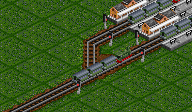
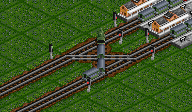
These two images show the problem. Both platforms are occupied, a third train is approaching. The signal before the junction just checks the station entry junction (it shows "Go!" if there is no train in this junction). Since that is the case, the third train approaches the signals in front of the platforms. However, it has to stop there as the platforms are blocked. In the best case (left image), it only waits at the wrong platform - the train at the other platform might leave earlier, so the other platform might be available sooner. In the worst case (right image) this train blocks the complete junction and creates a huge problem: The trains inside the station cannot leave, because the junction is blocked by this third train.
What is needed here is a signal which prevents the third train to enter the junction block when all platforms are blocked and the train cannot enter the station. Exactly for this reason pre signals have been invented.
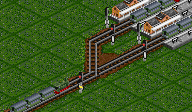
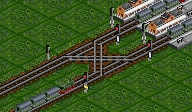
Here, pre signals are used, so the signal to the left shows "Stop!" even though the block is actually free. Thus, it prevents the train from entering the junction and blocking everything. Instead, any approaching train will wait in front of the junction, allowing trains to cross the junction and leave the station. Then a platform is free and the waiting train can proceed.
The following sections discuss the complete functionality in more detail.
Behaviour


There are three types of pre signals: Entry (yellow horizontal bar), exit (white vertical bar) and combo (yellow vertical bar), which is being entry and exit in one. All three types are useless on their own, they have to be used together to get the desired effects.
Entry pre signal (yellow horizontal bar)
This signal marks the begin of a pre signal block and only shows "Go!", when there is at least one Exit pre-signal (white vertical bar) or combo pre signal (yellow vertical bar) which shows "Go!" and the signal block itself is free.
Exit pre signal (white vertical bar)
This signal marks the end of a pre signal block and works exactly like the standard signal. It shows "Stop!" when the block behind it is occupied, and "Go!" if the block is free.
Combo pre signal (yellow vertical bar)
The combo signal is a mix of the other two. It acts as exit signal for the block before it and as an entry signal for the block behind.
Examples
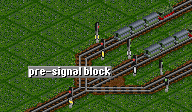
The entry signal to the far left interacts with the combo pre signal (left track) and the exit pre signal (middle track). Both these signals show "Stop!", as the tracks are in use. This means all signals relevant to the entry pre signal show "Stop!", which makes the entry signal also show "Stop!". The standard signal to the right does not matter because it is no pre signal.
What is interesting here is the different behaviour of the combo pre signal and the exit pre signal on the middle track when looking at it from the other driving direction. The exit pre-signal just works like a standard signal, the signal block (the junction) is free, so this side of the exit pre signal shows "Go!". The combo pre signal is different: It takes the state of all other combo and exit pre signals into account. The only exit pre-signal is at the track in the middle and shows "Stop!", which makes the combo signal show stop also for the other driving direction. It does not matter that no train can actually get from the left track to the middle one!
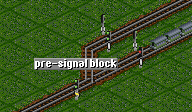
In this example there are two exit pre signals, the one on the right hand track showing "Stop!". The entry pre signal shows "Go!", because the block is free and there is one exit or combo signal showing "Go!" (at the left track). If that signal to the left would show "Stop!" just like the one to right, the entry signal would switch to "Stop!". That is exactly the behaviour which can be seen in the examples at the top of the page.
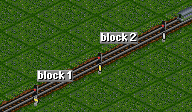
In the middle there is a combo pre signal. This connects block 1 and block 2. For block 1, it is the exit, for block 2 it is the entry. The exit pre signal of block 2 shows "Stop!". Since this exit signal is the only exit or combo signal of block 2, the combo signal between block 1 and 2 shows "Stop!" as well (since it acts as entry signal for block 2). Now, all exit or combo signals in block 1 show "Stop!", which causes the entry signal of block 1 to show "Stop!" as well. As soon as the exit pre signal of block 2 switches to "Go!", the other signals switch as well.
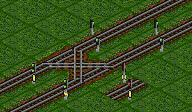
If there is no exit or combo pre signal which leads out of a block, all pre signals act like the standard signals, including the one-way combo signal. The two-way combo pre signal keeps showing "Stop!", regardless of any trains in the block.
